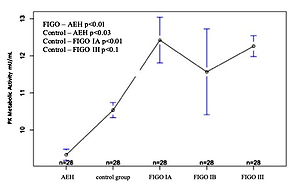Current issue
Archive
Manuscripts accepted
About the Journal
Editorial office
Editorial board
Section Editors
Abstracting and indexing
Subscription
Contact
Ethical standards and procedures
Most read articles
Instructions for authors
Article Processing Charge (APC)
Regulations of paying article processing charge (APC)
OBSTETRICS AND GYNAECOLOGY / RESEARCH PAPER
The pyruvate kinase activity in peripheral and uterine blood in women with atypical endometrial hyperplasia and endometrial cancer
1
Department of Gynecology and Oncology, University Hospital, Poland
2
Department of Clinical Biochemistry, Jagiellonian University Medical College, Poland
3
Department of Bioinformatics and Telemedicine, Jagiellonian University Medical College, Poland
4
Department of Gynecology and Oncology, Jagiellonian University Medical College, Poland
Submission date: 2020-09-29
Final revision date: 2021-05-26
Acceptance date: 2021-06-20
Online publication date: 2021-10-22
Corresponding author
Barbara Zapała
Department of Clinical Biochemistry, Jagiellonian University Medical College, Kopernika 15A, 31-501, Kraków, Poland
Department of Clinical Biochemistry, Jagiellonian University Medical College, Kopernika 15A, 31-501, Kraków, Poland
KEYWORDS
TOPICS
ABSTRACT
Introduction:
Pyruvate kinase in an enzyme that catalyzes the production of pyruvate and ATP as the final step of the glycolysis. Potential role of Pyruvate kinase in tumorigenesis was previously suggested, due to its altered activity in several tumors.
Material and methods:
This study looks at M2 isozyme of pyruvate kinase activity (M2-PK) measured in peripheral and uterine blood plasma in various stages of endometrial cancer (EC) as well as in precancerous state of atypical endometrial hyperplasia (AEH). Measurements were performed using spectrophotometric method in citrate plasma samples from peripheral and uterine blood. Study group included 84 patients with endometrial cancer, 28 patients with atypical endometrial hyperplasia and 23 non-cancerous controls.
Results:
Pyruvate kinase activity in EC group was 3-fold higher than in control group both in peripheral and uterine blood samples. Pyruvate kinase activity was also 3-fold higher in uterine blood when compared to peripheral blood samples. We also found statistically significant correlation between FIGO staging and detected activity with the M2-PK activity being 2-fold higher for FIGO1 than for FIGO3. We also describe a paradox in which the M2-PK activity in patients with atypical endometrial hyperplasia is lower than M2-PK activity in control group in peripheral blood samples, but higher in uterine blood samples.
Conclusions:
The measurement of citrate plasma pyruvate kinase metabolic activity varies greatly between samples collected from different sites and samples collected from patients with varied tumor staging. Further studies are needed in order to elucidate molecular pathways that are responsible for observed differences.
Pyruvate kinase in an enzyme that catalyzes the production of pyruvate and ATP as the final step of the glycolysis. Potential role of Pyruvate kinase in tumorigenesis was previously suggested, due to its altered activity in several tumors.
Material and methods:
This study looks at M2 isozyme of pyruvate kinase activity (M2-PK) measured in peripheral and uterine blood plasma in various stages of endometrial cancer (EC) as well as in precancerous state of atypical endometrial hyperplasia (AEH). Measurements were performed using spectrophotometric method in citrate plasma samples from peripheral and uterine blood. Study group included 84 patients with endometrial cancer, 28 patients with atypical endometrial hyperplasia and 23 non-cancerous controls.
Results:
Pyruvate kinase activity in EC group was 3-fold higher than in control group both in peripheral and uterine blood samples. Pyruvate kinase activity was also 3-fold higher in uterine blood when compared to peripheral blood samples. We also found statistically significant correlation between FIGO staging and detected activity with the M2-PK activity being 2-fold higher for FIGO1 than for FIGO3. We also describe a paradox in which the M2-PK activity in patients with atypical endometrial hyperplasia is lower than M2-PK activity in control group in peripheral blood samples, but higher in uterine blood samples.
Conclusions:
The measurement of citrate plasma pyruvate kinase metabolic activity varies greatly between samples collected from different sites and samples collected from patients with varied tumor staging. Further studies are needed in order to elucidate molecular pathways that are responsible for observed differences.
Share
RELATED ARTICLE
We process personal data collected when visiting the website. The function of obtaining information about users and their behavior is carried out by voluntarily entered information in forms and saving cookies in end devices. Data, including cookies, are used to provide services, improve the user experience and to analyze the traffic in accordance with the Privacy policy. Data are also collected and processed by Google Analytics tool (more).
You can change cookies settings in your browser. Restricted use of cookies in the browser configuration may affect some functionalities of the website.
You can change cookies settings in your browser. Restricted use of cookies in the browser configuration may affect some functionalities of the website.



